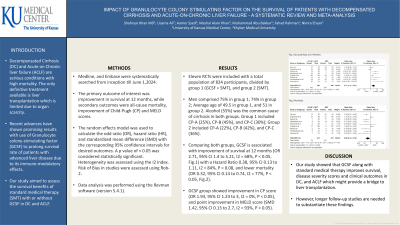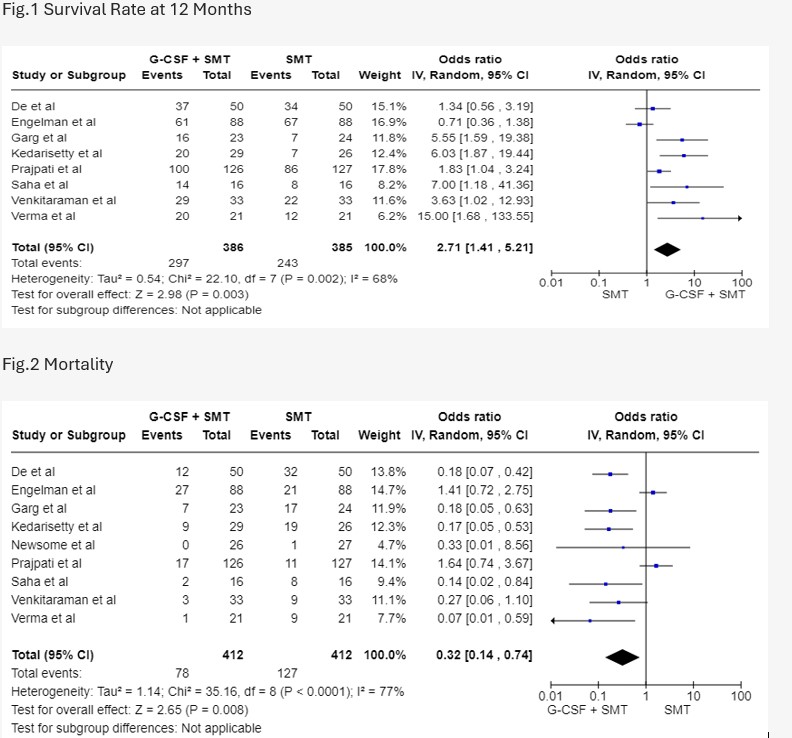Monday Poster Session
Category: Liver
P2974 - Impact of Granulocyte Colony Stimulating Factor on the Survival of Patients With Decompensated Cirrhosis and Acute-on-Chronic Liver Failure - A Systematic Review and Meta-Analysis
Monday, October 28, 2024
10:30 AM - 4:00 PM ET
Location: Exhibit Hall E

Has Audio
- SK
Shahryar Khan, MD
University of Kansas
Overland Park, KS
Presenting Author(s)
Shahryar Khan, MD1, Usama Ali, MBBS2, Aamer Syed, 3, Mashal Alam Khan, MBBS4, Muhammad Abu Bakkar, MBBS5, Fahad Rahman, MBBS6, Nimra Ehsan, 6
1University of Kansas, Overland Park, KS; 2Pak International Medical College Peshawar, Mardan, North-West Frontier, Pakistan; 3Khyber Medical College, Peshawar, North-West Frontier, Pakistan; 4Khyber Medical University, Overland Park, KS; 5Khyber Teaching Hospital, Peshawar, North-West Frontier, Pakistan; 6Khyber Medical University, Peshawar, North-West Frontier, Pakistan
Introduction: Decompensated Cirrhosis (DC) and Acute on Chronic liver failure (ACLF) are serious conditions with high mortality. The only definitive treatment available is liver transplantation which is limited due to organ scarcity. Recent advances have shown promising results with use of Granulocyte colony-stimulating factor (GCSF) to prolong survival rate of patients with advanced liver disease due to its immune-modulatory effects. Our study aimed to assess the survival benefits of standard medical therapy (SMT) with or without GCSF in DC and ACLF.
Methods: Medline, and Embase were systematically searched from inception till June 1,2024. The primary outcome of interest was improvement in survival at 12 months, while secondary outcomes were all-cause mortality, improvement of Child-Pugh (CP) and MELD scores. The random effects model was used to calculate the odd ratio (OR), hazard ratio (HR), and standardized mean difference (SMD) with the corresponding 95% confidence intervals for desired outcomes. A p value of < 0.05 was considered statistically significant. Heterogeneity was assessed using the I2 Index. Risk of Bias in studies were assessed using Rob-2. Data analysis was performed using the Revman software (version 5.4.1).
Results: Eleven RCTs were included with a total population of 824 participants, divided by group 1 (GCSF + SMT), and group 2 (SMT). Men comprised 75% in group 1; 74% in group 2; Average age of 49.5 in group 1, and 51 in group 2. Alcohol (55%) was the common cause of cirrhosis in both groups. Group 1 included CP-A (25%), CP-B (45%), and CP-C (30%); Group 2 included CP-A (22%), CP-B (42%), and CP-C (36%). Comparing both groups, GCSF is associated with improvement of survival at 12 months (OR 2.71, 95% CI 1.4 to 5.21, I2 = 68%, P < 0.05, Fig.1) with a Hazard Ratio 0.38, 95% CI 0.13 to 1.11, I2 = 84%, P = 0.08, and lower mortality (OR 0.32, 95% CI 0.14 to 0.74, I2 = 77%, P < 0.05, Fig.2). GCSF group showed improvement in CP score (OR 1.93, 95% CI 1.24 to 3, I2 = 0%, P < 0.05), and point improvement in MELD score (SMD 1.42, 95% CI 0.13 to 2.7, I2 = 93%, P < 0.05).
Discussion: Our study showed that GCSF along with standard medical therapy improves survival, disease severity scores and clinical outcomes in DC, and ACLF which might provide a bridge to liver transplantation. However, longer follow-up studies are needed to substantiate these findings.

Disclosures:
Shahryar Khan, MD1, Usama Ali, MBBS2, Aamer Syed, 3, Mashal Alam Khan, MBBS4, Muhammad Abu Bakkar, MBBS5, Fahad Rahman, MBBS6, Nimra Ehsan, 6. P2974 - Impact of Granulocyte Colony Stimulating Factor on the Survival of Patients With Decompensated Cirrhosis and Acute-on-Chronic Liver Failure - A Systematic Review and Meta-Analysis, ACG 2024 Annual Scientific Meeting Abstracts. Philadelphia, PA: American College of Gastroenterology.
1University of Kansas, Overland Park, KS; 2Pak International Medical College Peshawar, Mardan, North-West Frontier, Pakistan; 3Khyber Medical College, Peshawar, North-West Frontier, Pakistan; 4Khyber Medical University, Overland Park, KS; 5Khyber Teaching Hospital, Peshawar, North-West Frontier, Pakistan; 6Khyber Medical University, Peshawar, North-West Frontier, Pakistan
Introduction: Decompensated Cirrhosis (DC) and Acute on Chronic liver failure (ACLF) are serious conditions with high mortality. The only definitive treatment available is liver transplantation which is limited due to organ scarcity. Recent advances have shown promising results with use of Granulocyte colony-stimulating factor (GCSF) to prolong survival rate of patients with advanced liver disease due to its immune-modulatory effects. Our study aimed to assess the survival benefits of standard medical therapy (SMT) with or without GCSF in DC and ACLF.
Methods: Medline, and Embase were systematically searched from inception till June 1,2024. The primary outcome of interest was improvement in survival at 12 months, while secondary outcomes were all-cause mortality, improvement of Child-Pugh (CP) and MELD scores. The random effects model was used to calculate the odd ratio (OR), hazard ratio (HR), and standardized mean difference (SMD) with the corresponding 95% confidence intervals for desired outcomes. A p value of < 0.05 was considered statistically significant. Heterogeneity was assessed using the I2 Index. Risk of Bias in studies were assessed using Rob-2. Data analysis was performed using the Revman software (version 5.4.1).
Results: Eleven RCTs were included with a total population of 824 participants, divided by group 1 (GCSF + SMT), and group 2 (SMT). Men comprised 75% in group 1; 74% in group 2; Average age of 49.5 in group 1, and 51 in group 2. Alcohol (55%) was the common cause of cirrhosis in both groups. Group 1 included CP-A (25%), CP-B (45%), and CP-C (30%); Group 2 included CP-A (22%), CP-B (42%), and CP-C (36%). Comparing both groups, GCSF is associated with improvement of survival at 12 months (OR 2.71, 95% CI 1.4 to 5.21, I2 = 68%, P < 0.05, Fig.1) with a Hazard Ratio 0.38, 95% CI 0.13 to 1.11, I2 = 84%, P = 0.08, and lower mortality (OR 0.32, 95% CI 0.14 to 0.74, I2 = 77%, P < 0.05, Fig.2). GCSF group showed improvement in CP score (OR 1.93, 95% CI 1.24 to 3, I2 = 0%, P < 0.05), and point improvement in MELD score (SMD 1.42, 95% CI 0.13 to 2.7, I2 = 93%, P < 0.05).
Discussion: Our study showed that GCSF along with standard medical therapy improves survival, disease severity scores and clinical outcomes in DC, and ACLF which might provide a bridge to liver transplantation. However, longer follow-up studies are needed to substantiate these findings.

Figure: Forrest plots. Fig.1 Survival at 12 months, Fig.2 Mortality. Comparison between GCSF + SMT and SMT
Disclosures:
Shahryar Khan indicated no relevant financial relationships.
Usama Ali indicated no relevant financial relationships.
Aamer Syed indicated no relevant financial relationships.
Mashal Alam Khan indicated no relevant financial relationships.
Muhammad Abu Bakkar indicated no relevant financial relationships.
Fahad Rahman indicated no relevant financial relationships.
Nimra Ehsan indicated no relevant financial relationships.
Shahryar Khan, MD1, Usama Ali, MBBS2, Aamer Syed, 3, Mashal Alam Khan, MBBS4, Muhammad Abu Bakkar, MBBS5, Fahad Rahman, MBBS6, Nimra Ehsan, 6. P2974 - Impact of Granulocyte Colony Stimulating Factor on the Survival of Patients With Decompensated Cirrhosis and Acute-on-Chronic Liver Failure - A Systematic Review and Meta-Analysis, ACG 2024 Annual Scientific Meeting Abstracts. Philadelphia, PA: American College of Gastroenterology.
